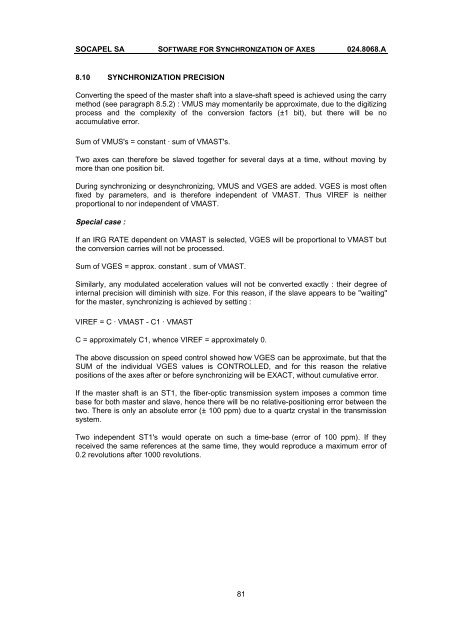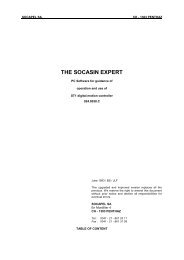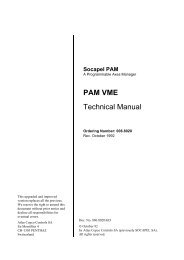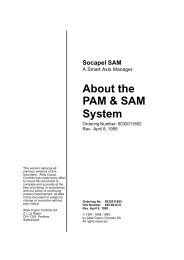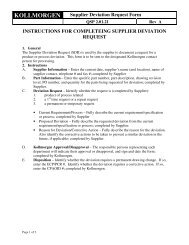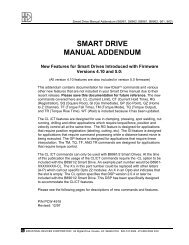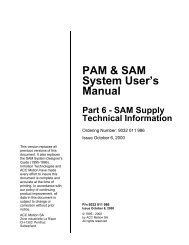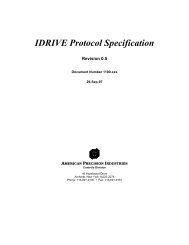Software for the synchronization of axes - Kollmorgen
Software for the synchronization of axes - Kollmorgen
Software for the synchronization of axes - Kollmorgen
Create successful ePaper yourself
Turn your PDF publications into a flip-book with our unique Google optimized e-Paper software.
SOCAPEL SA SOFTWARE FOR SYNCHRONIZATION OF AXES 024.8068.A8.10 SYNCHRONIZATION PRECISIONConverting <strong>the</strong> speed <strong>of</strong> <strong>the</strong> master shaft into a slave-shaft speed is achieved using <strong>the</strong> carrymethod (see paragraph 8.5.2) : VMUS may momentarily be approximate, due to <strong>the</strong> digitizingprocess and <strong>the</strong> complexity <strong>of</strong> <strong>the</strong> conversion factors (±1 bit), but <strong>the</strong>re will be noaccumulative error.Sum <strong>of</strong> VMUS's = constant . sum <strong>of</strong> VMAST's.Two <strong>axes</strong> can <strong>the</strong>re<strong>for</strong>e be slaved toge<strong>the</strong>r <strong>for</strong> several days at a time, without moving bymore than one position bit.During synchronizing or desynchronizing, VMUS and VGES are added. VGES is most <strong>of</strong>tenfixed by parameters, and is <strong>the</strong>re<strong>for</strong>e independent <strong>of</strong> VMAST. Thus VIREF is nei<strong>the</strong>rproportional to nor independent <strong>of</strong> VMAST.Special case :If an IRG RATE dependent on VMAST is selected, VGES will be proportional to VMAST but<strong>the</strong> conversion carries will not be processed.Sum <strong>of</strong> VGES = approx. constant . sum <strong>of</strong> VMAST.Similarly, any modulated acceleration values will not be converted exactly : <strong>the</strong>ir degree <strong>of</strong>internal precision will diminish with size. For this reason, if <strong>the</strong> slave appears to be "waiting"<strong>for</strong> <strong>the</strong> master, synchronizing is achieved by setting :VIREF = C . VMAST - C1 . VMASTC = approximately C1, whence VIREF = approximately 0.The above discussion on speed control showed how VGES can be approximate, but that <strong>the</strong>SUM <strong>of</strong> <strong>the</strong> individual VGES values is CONTROLLED, and <strong>for</strong> this reason <strong>the</strong> relativepositions <strong>of</strong> <strong>the</strong> <strong>axes</strong> after or be<strong>for</strong>e synchronizing will be EXACT, without cumulative error.If <strong>the</strong> master shaft is an ST1, <strong>the</strong> fiber-optic transmission system imposes a common timebase <strong>for</strong> both master and slave, hence <strong>the</strong>re will be no relative-positioning error between <strong>the</strong>two. There is only an absolute error (± 100 ppm) due to a quartz crystal in <strong>the</strong> transmissionsystem.Two independent ST1's would operate on such a time-base (error <strong>of</strong> 100 ppm). If <strong>the</strong>yreceived <strong>the</strong> same references at <strong>the</strong> same time, <strong>the</strong>y would reproduce a maximum error <strong>of</strong>0.2 revolutions after 1000 revolutions.81


